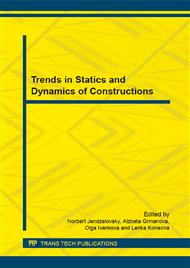[1]
A.K. El-Sayed, E.F. El-Salakawy, B. Benmokrane, Shear strength of FRP – Reinforced concrete beams without transverse reinforcement, ACI Structural Journal, March - April (2006).
DOI: 10.14359/15181
Google Scholar
[2]
A.K. El-Sayed, E.F. El-Salakawy, B. Benmokrane, Shear capacity of high – strength concrete beams reinforced with FRP bars, ACI Structural Journal, May – June (2006).
DOI: 10.14359/15316
Google Scholar
[3]
K.N. Rahal, Shear behavior of reinforced concrete beams with variable thickness of concrete side cover, ACI Structural Journal, March - April (2006).
DOI: 10.14359/15174
Google Scholar
[4]
T. Wasniewski, L. Sowa, M.E. Kaminska, Consequences of the applied of FRP composite bars as reinforcement of concrete, Inzynieria i Budownictwo Nr 11/06. (in Polish).
Google Scholar
[5]
T. Godycki-Cwirko, M. Wesołowski, Minimum reinforcement for shear in reinforced concrete structures, Inzynieria i Budownictwo Nr 2/06. (in Polish).
Google Scholar
[6]
A. Bousselham, O. Chaallal, Behavior of reinforced concrete T-beams strengthened in shear with carbon fiber-reinforced polymer – an experimental study, ACI Structural Journal, May – June (2006).
DOI: 10.14359/15311
Google Scholar
[7]
C. Pellegrino, C. Modena, Fiber – reinforced polymer shear strengthening of reinforced concrete beams: experimental study and analytical modelling, ACI Structural Journal, September – October (2006).
DOI: 10.14359/16924
Google Scholar
[8]
T. Godycki-Cwirko, Shear in reinforced concrete, Arkady, Warszawa 1968. (in Polish).
Google Scholar
[9]
M. Knauff, K. Klempka, Algorithms and graphs for design of reinforcement for shear according to Eurocode 2, Inzynieria i Budownictwo Nr 2/98. (in Polish).
Google Scholar
[10]
M.D. Brown, O. Bayrak, J.O. Jirsa, Design for shear based on loading conditions, ACI Structural Journal, July - August (2006).
Google Scholar
[11]
A.K. Tureyen, T.S. Wolf, R.J. Frosch, Shear strength of reinforced concrete T-beams without transverse reinforcement, ACI Structural Journal, September - October (2006).
DOI: 10.14359/16917
Google Scholar
[12]
I.Z. Zararis, M.K. Karaveziroglou, P.D. Zararis, Shear strength of reinforced concrete T-beams, ACI Structural Journal, September – October (2006).
Google Scholar
[13]
R. Jasinski, R. Kupczyk, W. Starosolski, M. Wieczorek, Research of reinforced concrete beams reinforced for shear with steel of different ductility, LIII Conference on Scientific problems of civil engineering, Wrocław - Krynica 2007. (in Polish).
Google Scholar
[14]
R. Jasinski, R. Kupczyk, W. Starosolski, M. Wieczorek, Research of failure RC shear beams reinforced with diverse ductility steel bars, Proceedings of the 6th International Conference on New Trends in Statics and Dynamics of Buildings, Bratislava, (2007).
Google Scholar
[15]
J. Anthony, B.S. Wolanski, Flexural behavior of reinforced and prestressed concrete beams using finite element analysis, A Thesis submitted to the Faculty of the Graduate School, Marquette University, in Partial Fulfillment of the Requirements for the Degree of Master of Science Milwaukee, Wisconsin May (2004).
Google Scholar
[16]
A.F. Barbosa, A study of models for nonlinear finite element analysis of concrete structures (Dissertation for attainment of Master Degree), Federal University of Minas Gerais.
Google Scholar
[17]
PN-EN 1992-1-1: 2004/AC Eurocode 2, Design of concrete structures - Part 1-1: General rules and rules for buildings, European Standard, (2010).
Google Scholar
[18]
M. Sh. Mahmood, A.M. Ibrahim, Finite element modeling of reinforced concrete beams strengthened with FRP laminates, European Journal of Scientific Research, Vol. 30 No. 4.
Google Scholar
[19]
SAS, ANSYS 7. 1 Finite Element Analysis System, SAS IP, Inc., (2003).
Google Scholar
[20]
M.Y.H. Bangash, Concrete and concrete structures: numerical modeling and applications, Elsevier Science Publishers Ltd., London, (1989).
Google Scholar
[21]
Y. Hemmaty, Modeling of the shear force transferred between cracks in reinforced and fibre reinforced concrete structures, in: Proc. of the ANSYS Conf., Vol. 1, Pittsburgh, PA (1998).
Google Scholar
[22]
D. Kachlakev, T. Miller, FE modeling of reinforced concrete structures strengthened with FRP lamiates, Final Report SPR 316, Oregon State University, (2001).
Google Scholar


